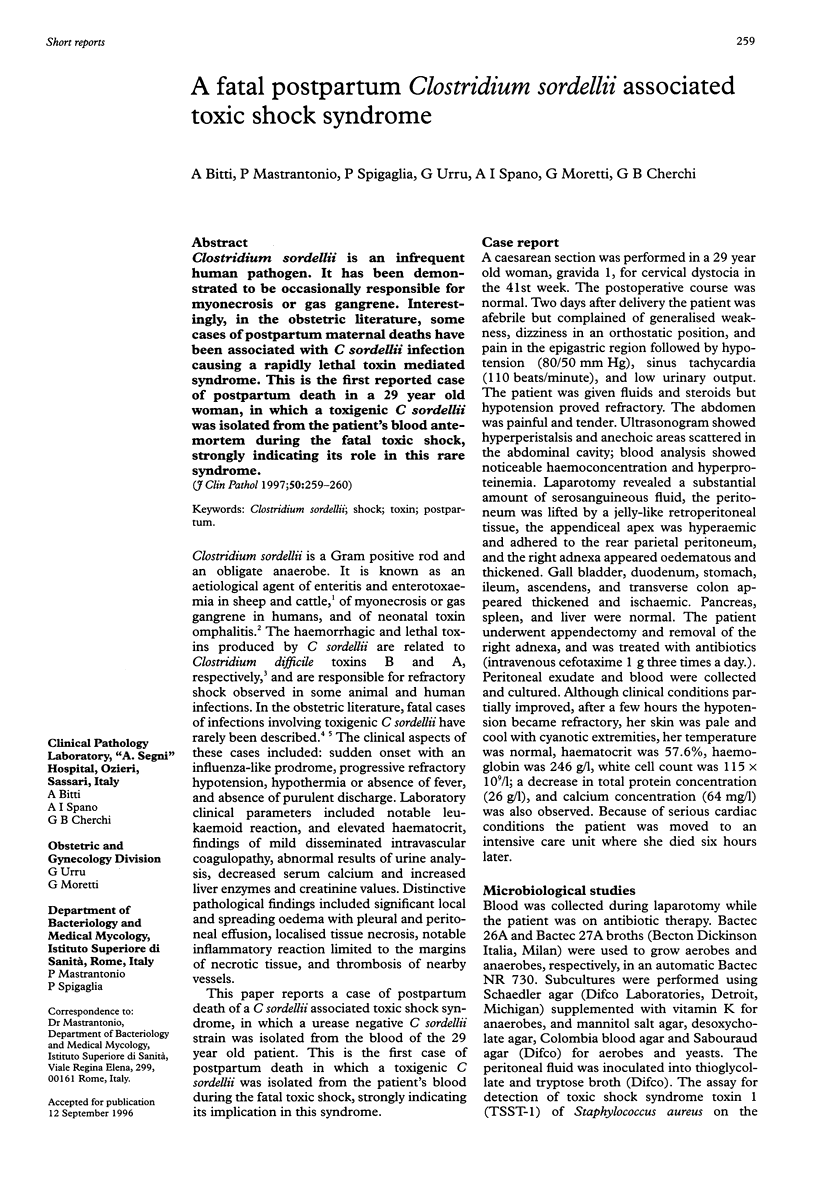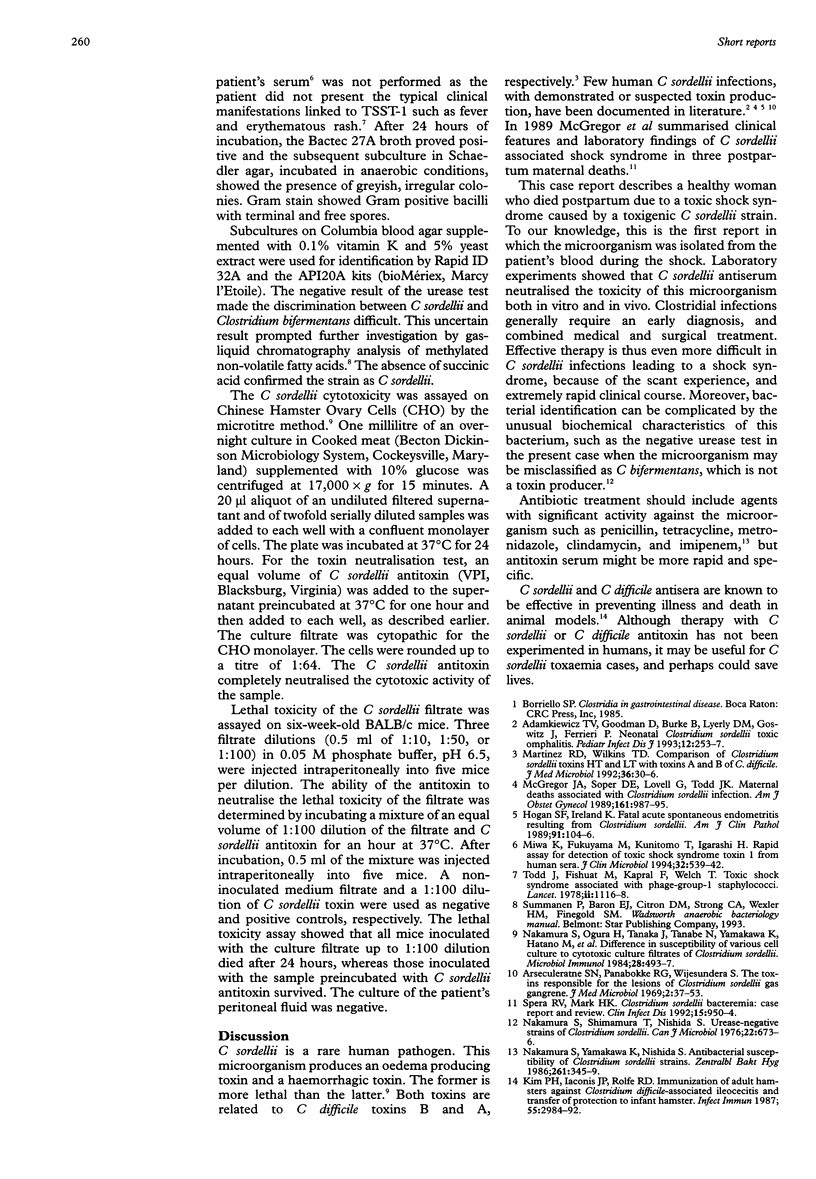Abstract
Clostridium sordellii is an infrequent human pathogen. It has been demonstrated to be occasionally responsible for myonecrosis or gas gangrene. Interestingly, in the obstetric literature, some cases of postpartum maternal deaths have been associated with C sordellii infection causing a rapidly lethal toxin mediated syndrome. This is the first reported case of postpartum death in a 29 year old woman, in which a toxigenic C sordellii was isolated from the patient's blood antemortem during the fatal toxic shock, strongly indicating its role in this rare syndrome.
Full text
PDF

Selected References
These references are in PubMed. This may not be the complete list of references from this article.
- Adamkiewicz T. V., Goodman D., Burke B., Lyerly D. M., Goswitz J., Ferrieri P. Neonatal Clostridium sordellii toxic omphalitis. Pediatr Infect Dis J. 1993 Mar;12(3):253–257. doi: 10.1097/00006454-199303000-00020. [DOI] [PubMed] [Google Scholar]
- Arseculeratne S. N., Panabokké R. G., Wijesundera S. The toxins responsible for the lesions of Clostridium sordelli gas gangrene. J Med Microbiol. 1969 Feb;2(1):37–53. doi: 10.1099/00222615-2-1-37. [DOI] [PubMed] [Google Scholar]
- Hogan S. F., Ireland K. Fatal acute spontaneous endometritis resulting from Clostridium sordelli. Am J Clin Pathol. 1989 Jan;91(1):104–106. doi: 10.1093/ajcp/91.1.104. [DOI] [PubMed] [Google Scholar]
- Kim P. H., Iaconis J. P., Rolfe R. D. Immunization of adult hamsters against Clostridium difficile-associated ileocecitis and transfer of protection to infant hamsters. Infect Immun. 1987 Dec;55(12):2984–2992. doi: 10.1128/iai.55.12.2984-2992.1987. [DOI] [PMC free article] [PubMed] [Google Scholar]
- Martinez R. D., Wilkins T. D. Comparison of Clostridium sordellii toxins HT and LT with toxins A and B of C. difficile. J Med Microbiol. 1992 Jan;36(1):30–36. doi: 10.1099/00222615-36-1-30. [DOI] [PubMed] [Google Scholar]
- McGregor J. A., Soper D. E., Lovell G., Todd J. K. Maternal deaths associated with Clostridium sordellii infection. Am J Obstet Gynecol. 1989 Oct;161(4):987–995. doi: 10.1016/0002-9378(89)90768-0. [DOI] [PubMed] [Google Scholar]
- Miwa K., Fukuyama M., Kunitomo T., Igarashi H. Rapid assay for detection of toxic shock syndrome toxin 1 from human sera. J Clin Microbiol. 1994 Feb;32(2):539–542. doi: 10.1128/jcm.32.2.539-542.1994. [DOI] [PMC free article] [PubMed] [Google Scholar]
- Nakamura S., Ogura H., Tanaka J., Tanabe N., Yamakawa K., Hatano M., Nishida S. Difference in susceptibility of various cell cultures to cytotoxic culture filtrates of Clostridium sordellii. Microbiol Immunol. 1984;28(4):493–497. doi: 10.1111/j.1348-0421.1984.tb00700.x. [DOI] [PubMed] [Google Scholar]
- Nakamura S., Shimamura T., Nishida S. Urease-negative strains of Clostridium sordellii. Can J Microbiol. 1976 May;22(5):673–676. doi: 10.1139/m76-099. [DOI] [PubMed] [Google Scholar]
- Nakamura S., Yamakawa K., Nishida S. Antibacterial susceptibility of Clostridium sordellii strains. Zentralbl Bakteriol Mikrobiol Hyg A. 1986 May;261(3):345–349. doi: 10.1016/s0176-6724(86)80052-9. [DOI] [PubMed] [Google Scholar]
- Spera R. V., Jr, Kaplan M. H., Allen S. L. Clostridium sordellii bacteremia: case report and review. Clin Infect Dis. 1992 Dec;15(6):950–954. doi: 10.1093/clind/15.6.950. [DOI] [PubMed] [Google Scholar]
- Todd J., Fishaut M., Kapral F., Welch T. Toxic-shock syndrome associated with phage-group-I Staphylococci. Lancet. 1978 Nov 25;2(8100):1116–1118. doi: 10.1016/s0140-6736(78)92274-2. [DOI] [PubMed] [Google Scholar]


